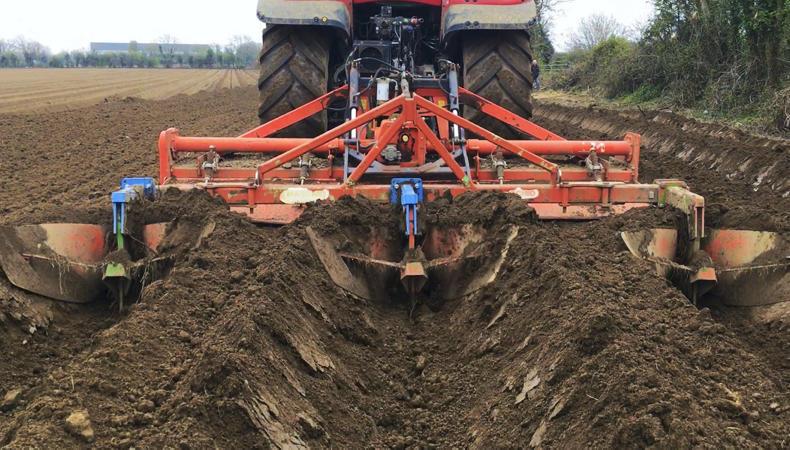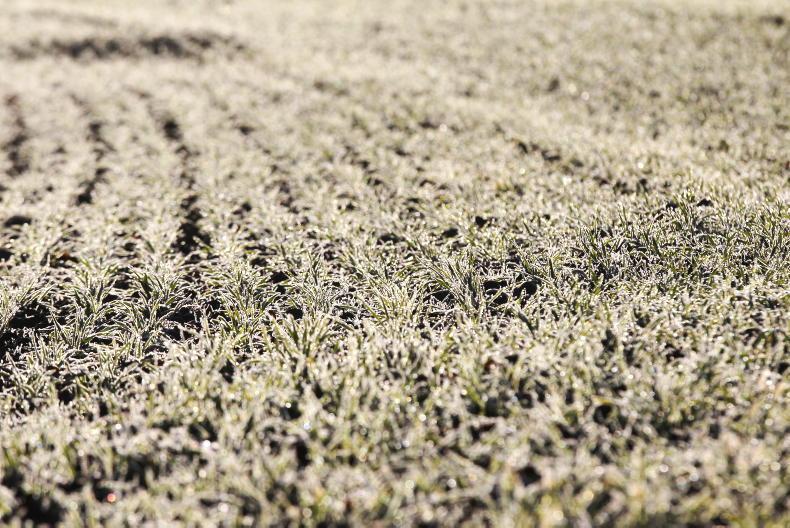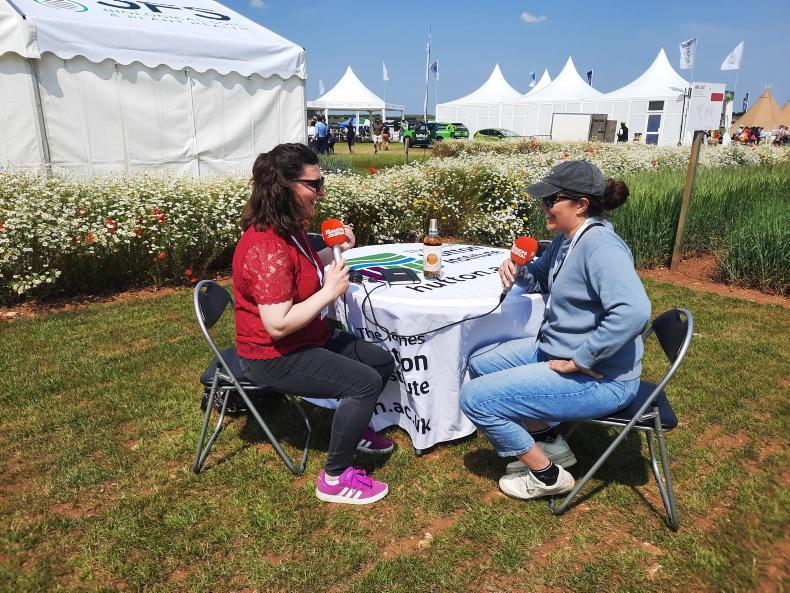
Rob Coleman,
Castlemagner,
Co Cork
It has been a good growing month in Castlemagner explains Rob. Helped in part by good spells of sunshine and adequate moisture levels. Ground conditions remain good despite having received 75.9mm of rain over the past month.
Spring bean emergence has been excellent. The crop was drilled at 45 seeds/m2 and plant counts are close to 45 plants/m2. However it appears that emergence is more consistent following his John Deere disc drill than his tine drill. There is some weevil notching evident but he does not intent to treat it. His Gangway spring barley has emerged and is looking very well. There are virtually no slugs present in the crop, “you would have to ask the question, does grazing the previous cover crop with sheep help with slug control?”, Rob remarks. The crop was brought up to 150kg N/ha by 19 April.
He will apply Inka Max (45g/ha) and Whorl (0.35l/ha) this week and he will apply an aphicide onto one tramline only.
Let’s talk aphids
When talking to Rob, he was after walking his crops with Teagasc research officer Louise McNamara, focusing on aphid control. Rob explained the need to understand the risk factors of BYDV such as sowing date, aphid species, degree day accumulation, green bridges, cropping history and that it’s a lot more complex that we might have first thought.
His winter barley is currently heading out. BYDV is present in some cases but crops are largely clean. On 17 April the crop received its T2 of Bravo (1l/ha), Bontima (1.2l/ha) plus Moddus 0.2l/ha), Novo4 (1l/ha), Magnite (2.5l/ha) and Binder (0.6l/ha). The crop will receive its T3 this week of Bravo (1l/ha) and Splice (1l/ha).
He essentially has two crops of winter wheat. His Cellule crop is very advanced and is currently heading out. He will decide on a head spray to apply to the crop with Red Mills agronomist Ollie Carter this week.
The flag leaf has now fully emerged on his Costello and Graham crops, which were brought up to 210kg N/ha. This week they will receive a T2 of Librax (1.6l/ha) and Bravo (1l/ha) as well as Magnite (2.5l/ha) and Novo4 (1l/ha).

Ronan Snow, Swords, Co Dublin
The weather has been somewhat broken in Swords explains Ronan, with a total of 32mm falling over the last month. Good weather over the weekend was welcomed. Despite the broken weather, he has virtually finished potato planting and all crops were planted in good conditions. The bulk of the planting was completed over a period of two weeks. He didn’t plough too far ahead on account of the weather. His earlier sown Queen potatoes are now beginning to emerge.
He sprayed his first 15ac of potatoes last week with Retro (2l/ha), Defy (4l/ha) and Shotput (0.5kg/ha) as there was a good flush of weeds present. There have been good spraying opportunities, despite gusts of 73km/hr recorded during Storm Hannah.
Depending on soil types, an application of Rooster Booster (6:5:20) was applied in the seed bed. We visited Ronan when he was planting a number of weeks ago, watch the full video online.
His early sown spring beans have received Amino B (1l/ha), Route (1lha), Super MN (1.25l/ha) and Basagran (0.85kg/ha). His Doubleshot spring wheat received 50kg N/ha last week and will receive a herbicide this week. His spring malting barley received 150l/ha of UAN recently to bring the crop up to 140kg N/ha.

Ronan Snow planting Rooster potatoes on the foot of Dublin Airport. Watch the full video online.
He is running a two-spray fungicide programme on his winter barley and it is due a head spray later this week. The crop also received Balear (1.5l/ha) and Terpal (1.25l/ha) early last week. The crop was brought up to 200kg N/ha.
There was a lot of yellow rust evident in his Bennington winter wheat earlier in April. The crop received its T1 at the end of the month consisting of Helix (1l/ha), Elatus Era (0.6l/ha) and Daconil (1.2l/ha), which helped knock the disease. He plans to bring the crop up to between 200-220kg N/ha.
His winter oilseed rape is in full flower and has been brought up to 230kg N/ha, the last of which was applied using UAN liquid nitrogen. He draws the liquid nitrogen (N) from Drummonds in Lusk.
The crop received Aztec (0.65l/ha), Filan (0.25kg/ha), Magtech (2.5l/ha) and Tarpoon (0.2l/ha) on 24 April.

David Moody
St Johnston,
Co Donegal
The past month has been an easy one to get through work explains David, with rainfall totalling just 24.4mm. “There wasn’t a day when you couldn’t do something, you were always making progress” he remarks. Temperatures of between 15°C and 2o°C for a period of eight days really helped drive on growth.
Spring sowing was completed in excellent conditions and all crops are now up. His spring malting barley was brought up to 115kg N/ha by 15 April. His malting barley and a lot of his feed barley were sown at the same time, but N will be applied on his feed crops across two splits. Around 50kg N/ha will be applied onto the crop this week. He also applied a spring herbicide last week to target chickweed, annual meadow grass and redshank.

David Moody applying a herbicide and trace element spray (mainly manganese) on Prospect malting barley last week.
His spring wheat has also fully emerged, with high establishment. The crop is due 60kg N/ha this week. He uses Sulfa CAN and the crop will be brought up to 140kg N/ha. All crops were rolled after sowing but there are still some signs of manganese deficiency in the crops.
David attributes this to the soil type, a common issue in the northwest. He has since applied a manganese trace element spray.
Awns peeping
The awns are peeping in his winter barley crops. Two weeks ago, David applied Cerone (0.4l/ha) on the crop. He runs a two-spray fungicide programme and it’s due to receive its T2 in the coming week. He expects to apply Bravo and Proline. Its T1 consisted of Siltra (0.45l/ha), Bravo (1l/ha) and Ceraide (1l/ha) applied at GS31.
His winter oats are a rich green colour and he is happy with this. They received a T1 at GS31 consisting of Riza (0.75l/ha), Talius (0.15l/ha) and Ceraide (1l/ha). “The crop isn’t massively advanced but that’s down to the variety, Mascani” he explains. Some of the crops were badly grazed with rabbits over the winter and he had to re-sow areas with spring barley.
His winter wheat crops have been brought up to 175kg N/ha.
It also received its T1 of Opus Team (1.2l/ha), Prothioconazole (0.3l/ha) and Bravo (1l/ha) last Monday. These crops remain fairly clean so far.
Read more
Grain prices: output forecasts pile more pressure on wheat
Potato consumption remains buoyant despite better weather

Rob Coleman,
Castlemagner,
Co Cork
It has been a good growing month in Castlemagner explains Rob. Helped in part by good spells of sunshine and adequate moisture levels. Ground conditions remain good despite having received 75.9mm of rain over the past month.
Spring bean emergence has been excellent. The crop was drilled at 45 seeds/m2 and plant counts are close to 45 plants/m2. However it appears that emergence is more consistent following his John Deere disc drill than his tine drill. There is some weevil notching evident but he does not intent to treat it. His Gangway spring barley has emerged and is looking very well. There are virtually no slugs present in the crop, “you would have to ask the question, does grazing the previous cover crop with sheep help with slug control?”, Rob remarks. The crop was brought up to 150kg N/ha by 19 April.
He will apply Inka Max (45g/ha) and Whorl (0.35l/ha) this week and he will apply an aphicide onto one tramline only.
Let’s talk aphids
When talking to Rob, he was after walking his crops with Teagasc research officer Louise McNamara, focusing on aphid control. Rob explained the need to understand the risk factors of BYDV such as sowing date, aphid species, degree day accumulation, green bridges, cropping history and that it’s a lot more complex that we might have first thought.
His winter barley is currently heading out. BYDV is present in some cases but crops are largely clean. On 17 April the crop received its T2 of Bravo (1l/ha), Bontima (1.2l/ha) plus Moddus 0.2l/ha), Novo4 (1l/ha), Magnite (2.5l/ha) and Binder (0.6l/ha). The crop will receive its T3 this week of Bravo (1l/ha) and Splice (1l/ha).
He essentially has two crops of winter wheat. His Cellule crop is very advanced and is currently heading out. He will decide on a head spray to apply to the crop with Red Mills agronomist Ollie Carter this week.
The flag leaf has now fully emerged on his Costello and Graham crops, which were brought up to 210kg N/ha. This week they will receive a T2 of Librax (1.6l/ha) and Bravo (1l/ha) as well as Magnite (2.5l/ha) and Novo4 (1l/ha).

Ronan Snow, Swords, Co Dublin
The weather has been somewhat broken in Swords explains Ronan, with a total of 32mm falling over the last month. Good weather over the weekend was welcomed. Despite the broken weather, he has virtually finished potato planting and all crops were planted in good conditions. The bulk of the planting was completed over a period of two weeks. He didn’t plough too far ahead on account of the weather. His earlier sown Queen potatoes are now beginning to emerge.
He sprayed his first 15ac of potatoes last week with Retro (2l/ha), Defy (4l/ha) and Shotput (0.5kg/ha) as there was a good flush of weeds present. There have been good spraying opportunities, despite gusts of 73km/hr recorded during Storm Hannah.
Depending on soil types, an application of Rooster Booster (6:5:20) was applied in the seed bed. We visited Ronan when he was planting a number of weeks ago, watch the full video online.
His early sown spring beans have received Amino B (1l/ha), Route (1lha), Super MN (1.25l/ha) and Basagran (0.85kg/ha). His Doubleshot spring wheat received 50kg N/ha last week and will receive a herbicide this week. His spring malting barley received 150l/ha of UAN recently to bring the crop up to 140kg N/ha.

Ronan Snow planting Rooster potatoes on the foot of Dublin Airport. Watch the full video online.
He is running a two-spray fungicide programme on his winter barley and it is due a head spray later this week. The crop also received Balear (1.5l/ha) and Terpal (1.25l/ha) early last week. The crop was brought up to 200kg N/ha.
There was a lot of yellow rust evident in his Bennington winter wheat earlier in April. The crop received its T1 at the end of the month consisting of Helix (1l/ha), Elatus Era (0.6l/ha) and Daconil (1.2l/ha), which helped knock the disease. He plans to bring the crop up to between 200-220kg N/ha.
His winter oilseed rape is in full flower and has been brought up to 230kg N/ha, the last of which was applied using UAN liquid nitrogen. He draws the liquid nitrogen (N) from Drummonds in Lusk.
The crop received Aztec (0.65l/ha), Filan (0.25kg/ha), Magtech (2.5l/ha) and Tarpoon (0.2l/ha) on 24 April.

David Moody
St Johnston,
Co Donegal
The past month has been an easy one to get through work explains David, with rainfall totalling just 24.4mm. “There wasn’t a day when you couldn’t do something, you were always making progress” he remarks. Temperatures of between 15°C and 2o°C for a period of eight days really helped drive on growth.
Spring sowing was completed in excellent conditions and all crops are now up. His spring malting barley was brought up to 115kg N/ha by 15 April. His malting barley and a lot of his feed barley were sown at the same time, but N will be applied on his feed crops across two splits. Around 50kg N/ha will be applied onto the crop this week. He also applied a spring herbicide last week to target chickweed, annual meadow grass and redshank.

David Moody applying a herbicide and trace element spray (mainly manganese) on Prospect malting barley last week.
His spring wheat has also fully emerged, with high establishment. The crop is due 60kg N/ha this week. He uses Sulfa CAN and the crop will be brought up to 140kg N/ha. All crops were rolled after sowing but there are still some signs of manganese deficiency in the crops.
David attributes this to the soil type, a common issue in the northwest. He has since applied a manganese trace element spray.
Awns peeping
The awns are peeping in his winter barley crops. Two weeks ago, David applied Cerone (0.4l/ha) on the crop. He runs a two-spray fungicide programme and it’s due to receive its T2 in the coming week. He expects to apply Bravo and Proline. Its T1 consisted of Siltra (0.45l/ha), Bravo (1l/ha) and Ceraide (1l/ha) applied at GS31.
His winter oats are a rich green colour and he is happy with this. They received a T1 at GS31 consisting of Riza (0.75l/ha), Talius (0.15l/ha) and Ceraide (1l/ha). “The crop isn’t massively advanced but that’s down to the variety, Mascani” he explains. Some of the crops were badly grazed with rabbits over the winter and he had to re-sow areas with spring barley.
His winter wheat crops have been brought up to 175kg N/ha.
It also received its T1 of Opus Team (1.2l/ha), Prothioconazole (0.3l/ha) and Bravo (1l/ha) last Monday. These crops remain fairly clean so far.
Read more
Grain prices: output forecasts pile more pressure on wheat
Potato consumption remains buoyant despite better weather
















SHARING OPTIONS